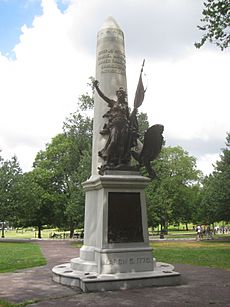Boston Massacre facts for kids
Quick facts for kids The Boston Massacre |
|
|---|---|

Engraving of the Massacre by Paul Revere
|
|
| Location | Boston, Massachusetts Bay Colony, British America |
| Date | March 5, 1770 |
|
Attack type
|
Shooting |
| Deaths | 5 |
|
Non-fatal injuries
|
6 |
| Perpetrators | British Army |
The Boston Massacre happened when five civilians (people who were not in the military) were shot and killed by British troops on March 5, 1770. The event happened in Boston, Massachusetts, which was a British colony at the time. It took place at night when a large mob got together outside of the Custom House. One British soldier named Hugh White had hit a boy with his rifle because the boy had insulted his commanding officer. A crowd began to gather and soon turned into a mob of angry people. More British soldiers came to help protect Hugh White from the people. The mob threw snowballs with clams inside them at the British soldiers. As the mob got larger and larger, the scene became more and more chaotic. Someone in the crowd yelled "fire." In the confusion, some of the soldiers fired into the crowd. Crispus Attucks, an African-American man, was one of the first people killed.
Contents
Trial
Eight British soldiers went to court after the Boston Massacre. Only two of them, Hugh Montgomery and Matthew Killroy, were found guilty of manslaughter. Their punishment was to have their thumbs branded (have their thumbs marked with a burn). John Adams was the lawyer who defended the British soldiers. He knew that many people would be upset with him for defending the soldiers, but he believed that everybody deserved a fair trial. (Adams would later become the President of the United States.)
After the Boston Massacre
Paul Revere, a man who worked with metals in Boston, made an engraving of the British soldiers shooting into the crowd. Many people saw the engraving and became angry.
Legacy
Contribution to American Revolution
The Boston Massacre is considered one of the most significant events that turned colonial sentiment against King George III and British Parliamentary authority. John Adams wrote that the "foundation of American independence was laid" on March 5, 1770, and Samuel Adams and other Patriots used annual commemorations (Massacre Day) to encourage public sentiment toward independence. Christopher Monk was the boy who was wounded in the attack and died in 1780, and his memory was honored as a reminder of British hostility.
Later events such as the Gaspee Affair and the Boston Tea Party further illustrated the crumbling relationship between Britain and its colonies. Five years passed between the massacre and outright war, and Neil York suggests that there is only a tenuous connection between the two. It is widely perceived as a significant event leading to the violent rebellion that followed. Howard Zinn argues that Boston was full of "class anger". He reports that the Boston Gazette published in 1763 that "a few persons in power" were promoting political projects "for keeping the people poor in order to make them humble."
Commemorations

The massacre was remembered in 1858 in a celebration organized by William Cooper Nell, a black abolitionist who saw the death of Crispus Attucks as an opportunity to demonstrate the role of African Americans in the Revolutionary War. Artwork was produced commemorating the massacre, changing the color of a victim's skin to black to emphasize Attucks' death. In 1888, the Boston Massacre Monument was erected on the Boston Common in memory of the men killed in the massacre, and the five victims were reinterred in a prominent grave in the Granary Burying Ground.
The massacre is reenacted annually on March 5 under the auspices of the Bostonian Society. The Old State House, the massacre site, and the Granary Burying Ground are part of Boston's Freedom Trail, connecting sites important in the city's history.
Interesting facts about the Boston Massacre
- The British use a different name for the Boston Massacre: "The Incident on King Street."
- More than one-half of Boston's population attended the funerals of the victims.
- "Reasonable Doubt" was first used in the trial of British Captain Preston, who was honorably cleared of murder charges.
- The ability to read from the Bible helped two British soldiers escape the death penalty.
- The two soldiers who were found guilty were given reduced sentences and were branded on their thumbs with the letter M for "Manslaughter."
- Both sides used propaganda in an attempt to make the other side look like they were in the wrong.
Related pages
Images for kids
See also
 In Spanish: Masacre de Boston para niños
In Spanish: Masacre de Boston para niños



